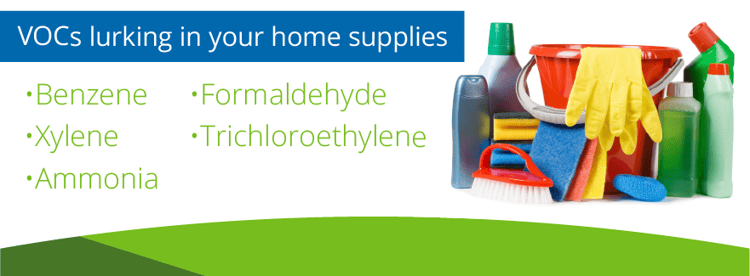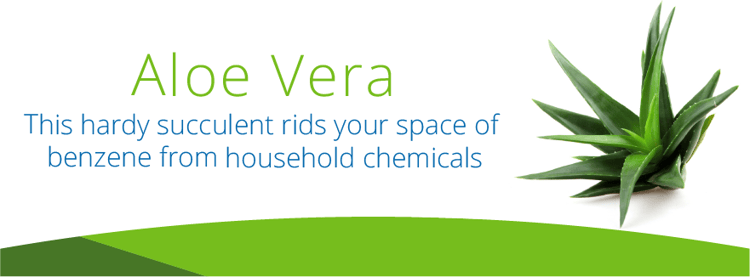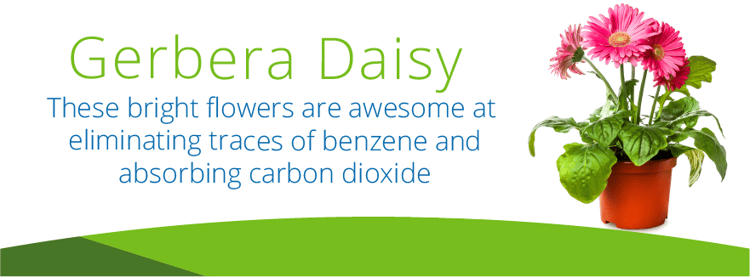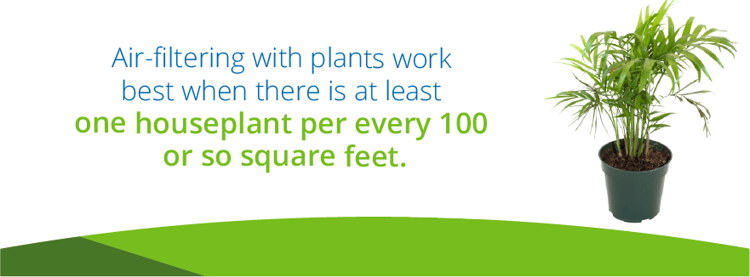
When we think of poor air quality, we may have associations of contaminants such as heavy metals from the freeway, factory emissions or that semi-truck blocking our view with black smoke coming out its top — mostly things that happen outdoors.
- What’s in the Air We Breathe?
- Types of Air-Filtering Houseplants
- How Many Air-filtering Houseplants Do I Need to Clean the Air?
We assume we are safe from air pollutions inside, but the reality is there are many pollutants that accumulate and get trapped in the places we spend the most time — our homes and offices — particularly during the winter when windows tend to stay closed for months on end. These stagnant environments allow volatile organic compounds (VOCs for short) to build up, which eventually become hazardous for us to breathe in.
What’s in the Air We Breathe?
VOCs are kind of a catchall group of carbon-based chemicals that evaporate easily at room temperature. People can typically smell high levels of many VOCs, like paint, but some have no odor and can go undetected. Unfortunately, VOCs come hidden in many common household items, such as scented personal care products, wood particleboard, dyed leather, inks and glues — the list goes on.
Here are a few of the usual types of VOCs lurking in your home supplies:

- Benzene: Found in everything from plastics and resins, to drugs, pesticides and tobacco smoke, benzene causes drowsiness, eye irritation and dizziness. In more extreme cases, benzene can cause headaches, confusion and an elevated heart rate.
- Xylene: Found in leather goods, printing materials, tobacco smoke, rubber and car exhaust, xylene can irritate the throat or mouth. However, there are m more serious problems that stem from xylene exposure. This toxic agent can cause the usual headaches and dizziness, as well as liver damage, heart problems, confusion and damage to the liver and kidneys. In extreme cases, exposure can result in a coma.
- Ammonia: Generally found in household cleaning products, fertilizer and floor wax, exposure to ammonia can cause coughing, sore throat and eye irritation.
- Formaldehyde: Found in paper products like bags or napkins, paper towels, plywood and particle board, short-term exposure to formaldehyde can cause nose and throat irritation and occasional swelling of the lungs and larynx.
- Trichloroethylene: Typically found in inks, lacquers and solvents like paint thinner, exposure to trichloroethylene can cause nausea, vomiting, headache, dizziness — sometimes followed by drowsiness, or even induce a coma.
Fortunately, thanks to NASA (yes, NASA!), we now know which house plants can best keep indoor air fresh and clean — proving there are more reasons to get a plant than just trying to prove that you’re responsible enough for a pet.
A Little Background
In the late 1970s, there was a movement toward cutting energy usage, due to multiple factors, like high gas prices and the rising cost of heating and cooling large buildings. While some of the changes implemented as a result did work to slash utility bills, it came at the cost of fresh air freely circulating through office buildings and high-rise apartments. Throughout the better part of the next decade, people started complaining of headaches, sinus and respiratory issues, dizziness, rashes and a whole slew of unpleasant symptoms. This phenomenon became known as “sick building syndrome.”
NASA discovered what was essentially “sick building syndrome” took place in the sealed space habitats during the Apollo missions. In the late 1980s, NASA joined forces with the Associated Contractors of America (ALCA), in an effort to uncover the benefits of using houseplants to clean the air, building on the principal of how our forests function as a means to filter out carbon emissions and other forms of pollution on a large scale. This study was known as the clean air study.
Since spacecraft are hermetically sealed indoor spaces, the VOC buildup, especially on longer missions, could have an adverse effect on astronauts. As result, the space agency found that adding plants to the equation bring the benefits of nature indoors, eliminating many of the harmful compounds in the air.
While we’ve yet to see much of the power of plants in space, NASA scientists have uncovered some pretty fantastic benefits our green friends provide. The idea behind this is that, our whole existence is contingent on our symbiotic relationship with plants and their ability to clean the air. It seems obvious that humans experience health problems when sealed away from our natural habitats, and despite our ongoing difficulties with climate change, carbon emissions and general pollution, the air outdoors remains better for us than that of our indoor safe havens. What came out of the NASA study was adding potted plants to our Earth-bound, indoor habitats helps make them a healthier place.
Types of Air-Filtering Houseplants
Here are 11 of the best air-filtering houseplants you can get to clean your indoor air:
-
Aloe Vera

Healer of burns and sometimes used as a juice ingredient, aloe vera is a beloved home remedy known for its myriad healing abilities. Aside from its gel, aloe vera also works wonders as an air filtering plant. This hardy succulent rids your space of benzene from household chemicals. If you feel that perhaps a plant is just “too much right now,” aloe plants are very hard to kill and need very little attention.
-
Spider Plant
These long-leafed plants fight indoor pollution from formaldehyde, benzene, xylene and carbon monoxide. Spider plants are among the ranks of the more resilient houseplants, which is a good option if you tend to forget to water plants from time to time, or even forget they exist altogether. Keep your spider plant in an area with indirect sun and cooler temperatures. In addition to its low maintenance disposition, the spider plant is safe for homes with pets and small children.
-
Snake Plant (aka Mother-in-Law’s Tongue)
The snake plant is one of the great heroes of the air-filtering game, excellent at getting formaldehyde out of the air —, which is found, surprisingly, in more than just your taxidermy collection. Formaldehyde hides out in a whole slew of household products, particularly the key players in the bathroom scene: cleaning products, toilet paper, Kleenex, and an assortment of personal care products. Naturally, the bathroom is a good place for this one plant — it thrives in steamy, humid conditions. It also does do well in the bedroom, though.
In addition to its formaldehyde-fighting abilities, snake plants absorb carbon dioxide and release oxygen during the night — which is interesting, as most plants do the opposite. As a result, expect a little oxygen boost while you sleep. Snake plants are low maintenance, and while they do well in the bathroom, they do really well with very little watering and drier conditions.
-
Boston Fern
The Boston Fern is a beautiful plant that doubles as a humidifier. These ferns are great for people with dry skin, as they add moisture back into the air — which is fantastic during cold winter months when heaters are running and fresh air is a distant memory.
Boston Ferns help eliminate formaldehyde, so they tend to work well in rooms you might store paper products, like the kitchen. Be sure to keep these guys out of the sun, though. Boston ferns prefer to hang out in a cooler location with indirect sunlight and high humidity (perhaps the bathroom).
Though Boston Ferns are relatively low maintenance, they pretty much need to stay wet at all times. Be sure to check the soil on a daily basis, mist the leaves and give it a good soak at least once a month. Do note, that if the leaves start looking a bit yellow, that means the plant needs to be watered.
-
Peace Lily
The small, but mighty peace lily has some serious air-cleaning potential, working to filter out a solid list of pollutants like benzene, ammonia, formaldehyde and trichloroethylene. Brown thumbs rejoice — they are also relatively easy to grow, and their flowers remain in bloom for a good portion of the summer months. Peace lilies appreciate the shade, so avoid placing them in direct sunlight.
Additionally, these lilies need to be kept moist the majority of the time, but just be careful you don’t overwater them. A quick note to those afflicted with seasonal allergies — while peace lilies are great at getting rid of some of the more sinister-sounding indoor toxins, they do add pollen and floral scents into the mix, so you might not want to keep several in a single room, lest you start sneezing. Avoid them altogether if you have severe allergies. If that’s the case, an aloe vera plant or a fern may prove to be a better fit.
-
Eucalyptus
Another plant associated with its medicinal properties, the eucalyptus plant has long been used for ailments (particularly respiratory issues) that run the gamut from bronchitis, pneumonia, asthma and tuberculosis. Eucalyptus plants can sometimes be a bit tricky to find in a size reasonable for a home, but if you can, it’s definitely worth your while.
If you can find a large potted eucalyptus plant, it may be a nice addition to an office building lobby or other wide open indoor space. The benefits here come from the leaves. They are filled with tannins, which activate the fluids in your nasal passages. Breathing in the scent of the eucalyptus helps ward off respiratory illness and helps you breathe a little easier.
-
English Ivy
The English Ivy plant is perfect for those who have pets in the home as it can reduce the amount of airborne fecal matter. It can also absorb formaldehyde, which is commonly found in numerous household products, as well as furniture and carpeting treatments.
English Ivies are great for absorbing benzene, which can help improve focus during the day, making this a great plant for the workplace. Since English Ivies appreciate a good mix of sun and shade, experiment by placing it in different locations and see what works best — perhaps indirect sunlight would be a good starting point. Aside from its somewhat unclear preference for sunlight, this plant needs to be watered here and there (no need to stick to a strict schedule) and kept moist by misting regularly.
-
Chrysanthemum
Mums are a pretty standard find at any nursery or home improvement store. They come in a variety of colors, so this is one of the better opportunities to complement your décor with houseplants. There’s more to the Chrysanthemum than good looks, though — these pretty powerhouses can help eliminate benzene, a chemical typically found in various household detergents, paints, glues and even some kinds of plastics.
Mums do best in an environment with lots of natural sunlight and prefer being stationed near windows. Avoid overwatering, but do not wait for plants to start wilting before watering. Water when the soil begins to feel dry to the touch.
-
Gerbera Daisy

Gerbera (or Gerber) daisies are awesome at eliminating traces of benzene and absorbing carbon dioxide. Like the snake plant, they emit bursts of oxygen overnight — which helps improve your sleep quality. These daisies aren’t too hard to care for, but they do require a bit more effort than peace lilies or aloe plants. They like well-drained soil, so be sure pots have drainage holes. These little cuties like bright light as well, so be sure to keep them near a window. Leaves should be misted a couple times a week (yes, it’s a bit of a commitment).
-
Chinese Evergreen
The Chinese Evergreen fights against a number of VOCs found in the air — benzene and formaldehyde in particular — due to the fact that it includes small red berries that also do their part to remove toxins. This plant enjoys warmer temperatures but indirect sunlight, and it needs to be thoroughly drained after watering.
Be aware if you have pets or small children in your home as the Chinese Evergreen’s sap is poisonous. It can potentially cause skin rashes and irritations as well as swelling of the throat, mouth and other areas if ingested.
-
Bamboo Palm
Another houseplant that acts as a natural humidifier, the Bamboo Palm eliminates benzene, formaldehyde and trichloroethylene from the air. These palms tend to grow pretty tall — we’re talking up to 12 feet — so they’ll likely work better in a larger home, or perhaps a lobby area. Bamboo palms like very bright, yet indirect sunlight and do not enjoy being overwatered.
How Many Air-filtering Houseplants Do I Need to Clean the Air?

According to the NASA study, air-filtering with plants tends to work best when there is at least one houseplant per every 100 or so square feet — this could be one large potted plant (like the bamboo palm or eucalyptus), or multiple small ones scattered around your home or office space. It’s also worth noting that the house plants should be potted in a soil mixture that contains lots of nutrients. The air filter-effect doesn’t work well with air plants or those that use water in lieu of soil.
While plants make excellent air filters and add an additional layer of style to your home, office or hermetically-sealed spacecraft, it’s a good idea to invest in air filters as well. Be sure to check that the filters in your heating and air conditioning units changed on a regular basis to ensure the best possible air quality.
Contact Smart Touch Energy for HVAC maintenance.



